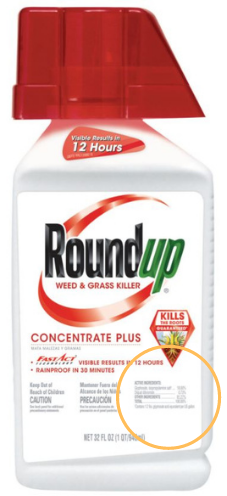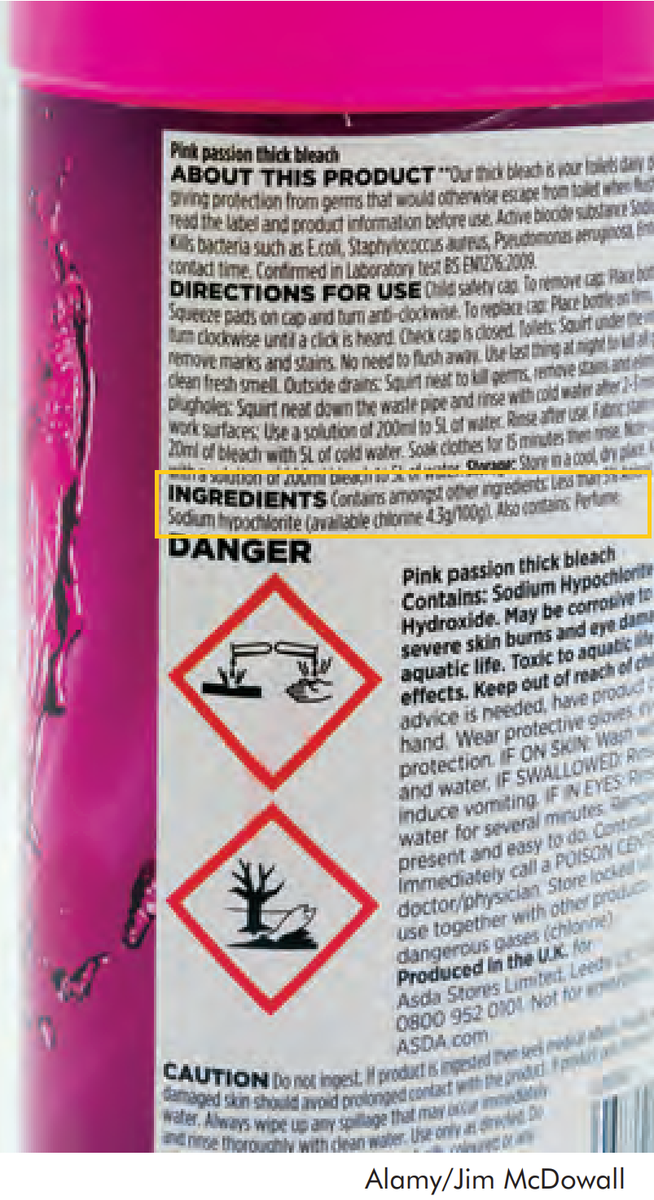Gateway on Pesticide Hazards and Safe Pest Management
How To Find Ingredients in Pesticide Products
Beyond Pesticides offers resources below to evaluate the health and ecological effects of specific chemical exposure from ACTIVE INGREDIENTS in pesticide products, as well as regulatory information and supporting scientific documents. Because various pesticide products can contain more than one active ingredient, it is important to READ the LABEL to determine chemical components.
With 192 different active ingredients and counting, it is essential to establish the connection between the use of these chemicals and their respective hazards.
View the step-by-step guide on how to search for the active ingredient(s) in pesticide products below:
- Go to U.S. EPA's Pesticide Product and Label System and enter the product name. The generic product name may vary.
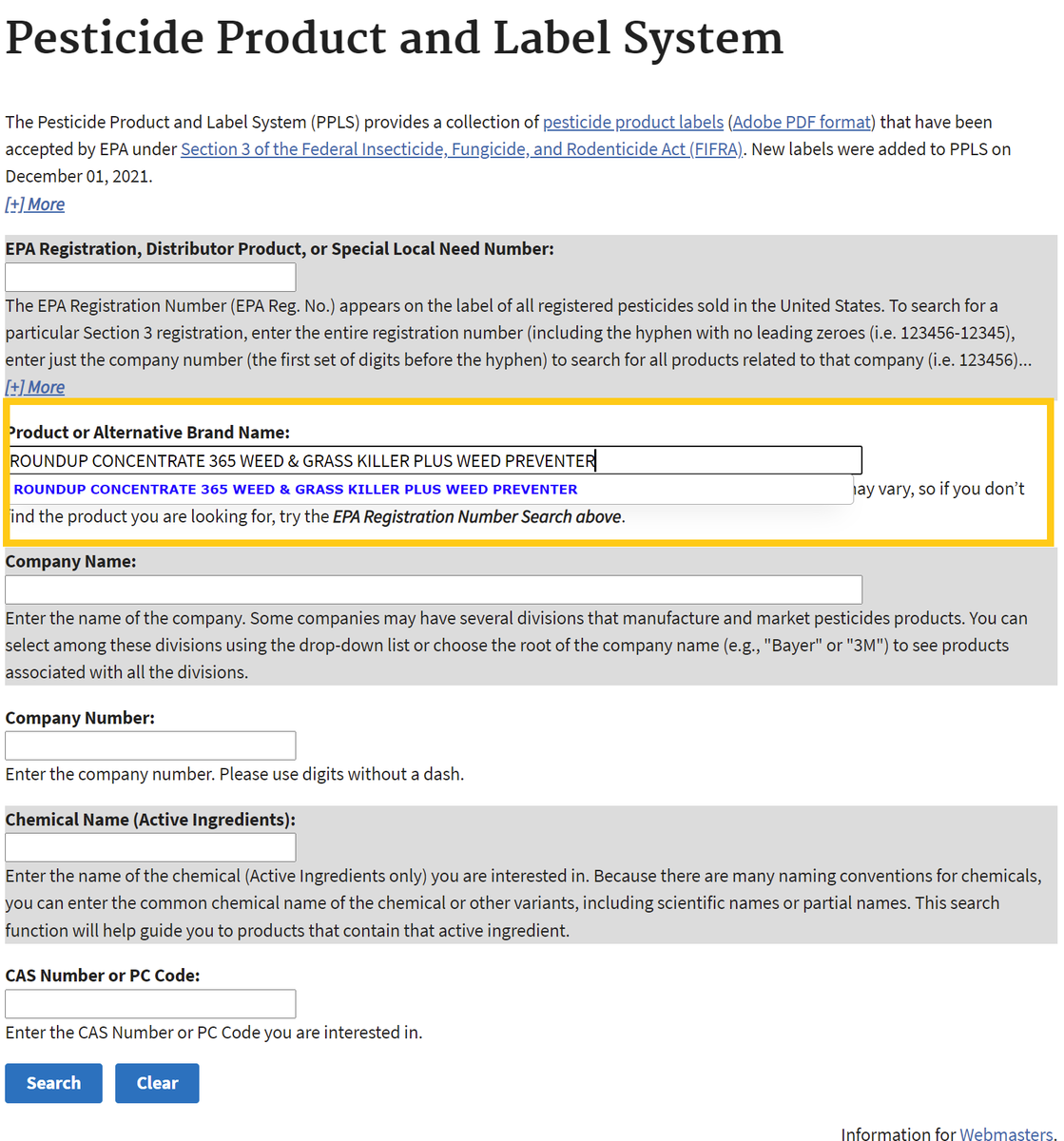
- After searching, click on the chemical ingredients tab or the link for the most recent label to find Active Ingredients.
Chemical List Label List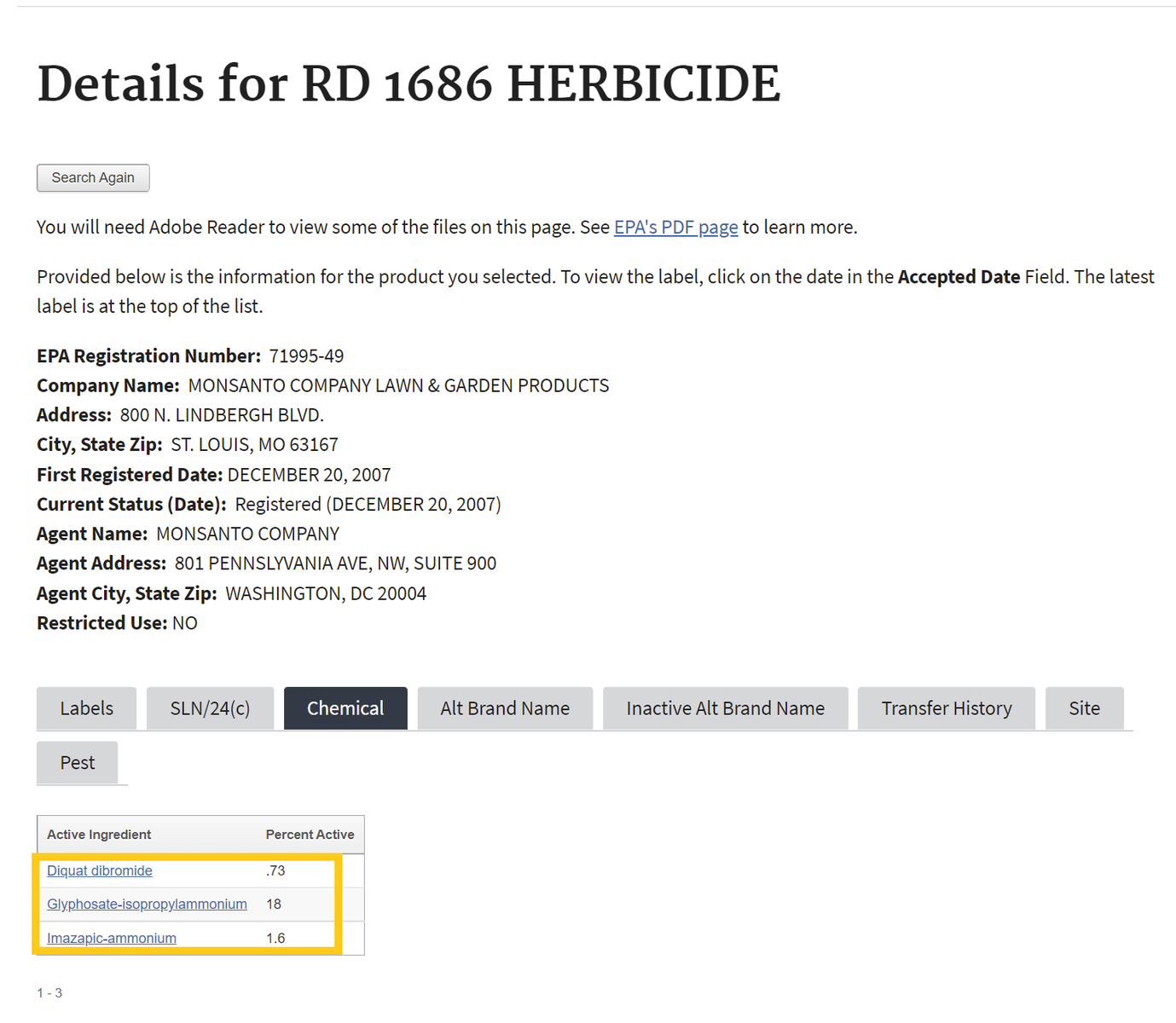
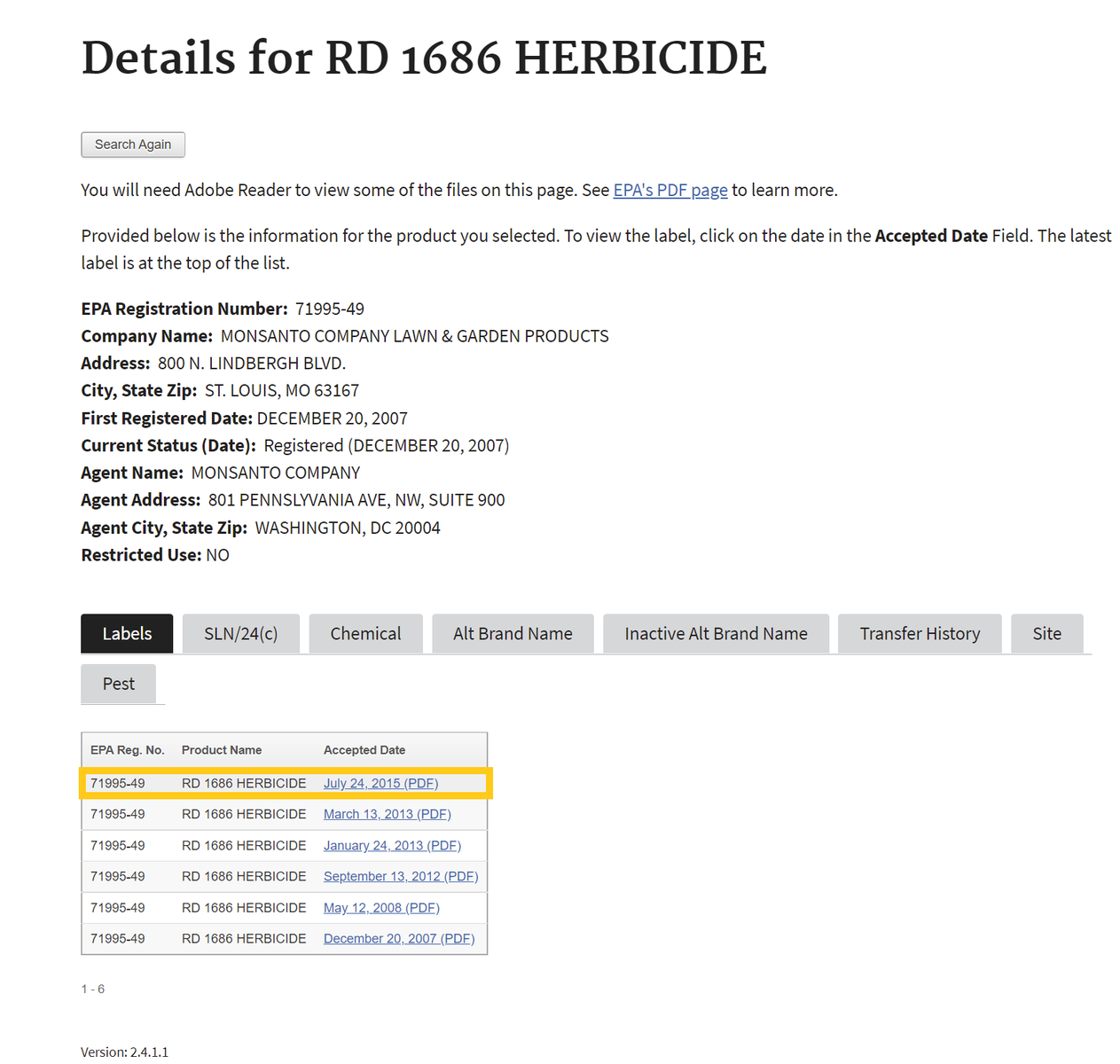
If one selects the chemical ingredients tab, skip to Step 4 . If not, proceed to step number 3 - To find the active ingredient(s) on the label, search for the page in the document containing the date of registration. Usually, the active ingredients section occurs within the first few pages of the label document.
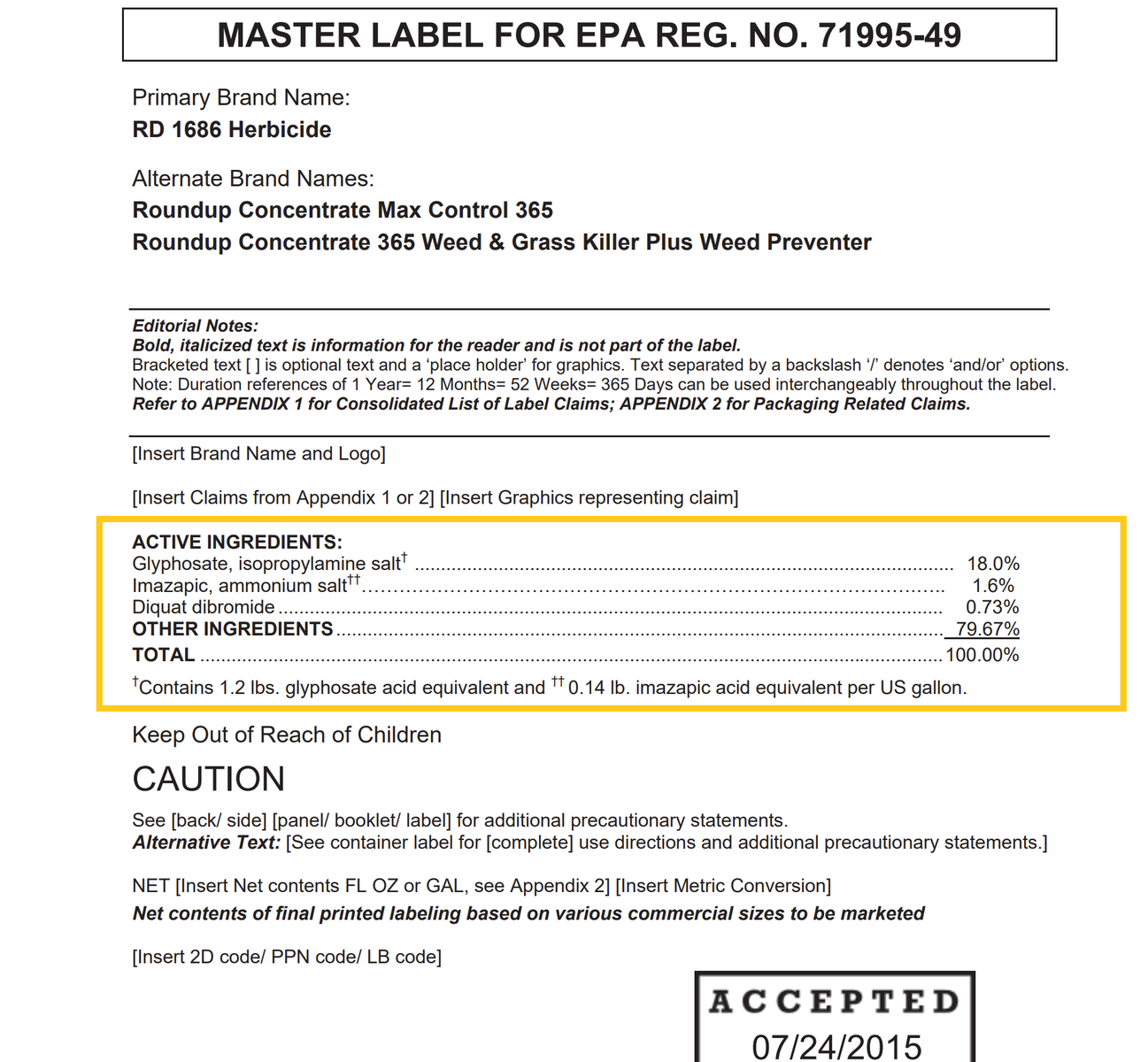
- Return to the Beyond Pesticides Gateway and search for the active ingredient name in the yellow box to the right or from the list below.
Paraquat/Paraquat dichloride
General Information
- Fact Sheet: Paraquat.pdf
- Product Names:
- Chemical Class: Quaternary nitrogen herbicide
- Uses: Preplant or preemergence weed control on vegetables, grains, cotton, grasses, sugar cane, peanuts, potatoes, and tree plantation areas; postemergence around fruit crops, vegetables, trees, vines, grains, soybeans, and sugar cane; during the dormant season on clover and other legumes; as a desiccant or harvest aid on cotton, dry beans, soybeans, potatoes, sunflowers, and sugar cane; and as a post harvest desiccant on staked tomatoes; applied to pine trees to induce resin soaking. non-crop areas include public airports, electric transformer stations and around commercial buildings.
- Alternatives: Organic agriculture, Least-toxic weed control
- Beyond Pesticides rating: Toxic
Health and Environmental Effects
- Cancer: Likely (86)
- Endocrine Disruption: Not documented
- Reproductive Effects: Yes (13)
- Neurotoxicity: Yes (87, 88, 89)
- Kidney/Liver Damage: Yes (4)
- Sensitizer/ Irritant: Yes (4)
- Birth/Developmental: Not documented
- Detected in Groundwater: Yes (4)
- Potential Leacher: Likely (94, 95)
- Toxic to Birds: Yes (4)
- Toxic to Fish/Aquatic Organisms: Yes (91, 92, 93)
- Toxic to Bees: Likely (90)
Additional Information
- Regulatory Status:
- EPA Reregistration Eligibility Decision (RED) signed (8/1997)
- Supporting information:
- Beyond Pesticide Comments (March 2025)
- Beyond Pesticide Comments (March 2024)
- Extoxnet Paraquat Factsheet (Extension Toxicology Network)
- PAN Pesticides Database: Paraquat dichloride (Pesticide Action Network)
- Adverse Health Effects Caused by Paraquat (Public Eye)
- Studies:
- Drosophila DJ-1 Mutants Are Selectively Sensitive to Environmental Toxins Associated with Parkinson’s Disease. Meulener, M. et. al. 2005. Current Biology 15(17):1572-1577.
- Age-related irreversible progressive nigrostriatal dopaminergic neurotoxicity in the paraquat and maneb model of the Parkinson's disease phenotype.. Thiruchelvam, M., et al. 2003. Eur J Neurosci 18(3):589-600
- Agricultural pesticide use and risk of glioma in Nebraska, United States. Lee, W., et al. 2005. Occupational and Environmental Medicine 62(11):786-792
- Association between Parkinson's Disease and Cigarette Smoking, Rural Living, Well-Water Consumption, Farming and Pesticide Use: Systematic Review and Meta-Analysis.. Breckenridge CB, Berry C, Chang ET, et al. 2016. PLoS One.11(4):e0151841
- Cognitive impairment and increased Aβ levels induced by paraquat exposure are attenuated by enhanced removal of mitochondrial H2O2.. Chen, L., et al. 2011. Neurobiol Aging. [Epub ahead of print
- Combined exposure to agriculture pesticides, paraquat and maneb, induces alterations in the N/OFQ-NOPr and PDYN/KOPr systems in rats: Relevance to sporadic Parkinson's disease.. Bastías-Candia S, Di Benedetto M, D'Addario C, Candeletti S, Romualdi P. 2013. Environ Toxicol. doi: 10.1002/tox.21943
- Developmental exposure to the pesticides paraquat and maneb and the Parkinson's disease phenotype.. Thiruchelvam, M., et al. 2002. Neurotoxicology 23(4-5):621-633
- Developmental pesticide exposures and the Parkinson's disease phenotype.. Cory-Slechta D.A., et al. 2005. Birth Defects Res A Clin Mol Teratol 73:136–139
- Dopamine Transporter Genetic Variants and Pesticides in Parkinson’s Disease. Ritz BR, et al. 2009. Environ Health Perspect 117(6)
- Effects of melatonin in rats in the initial third stage of pregnancy exposed to sub-lethal doses of herbicides.. Almeida LL, Teixeira ÁAC, Soares AF, Cunha FMD, et al. Acta Histochem. 119(3):220-227.
- Environmental exposure to pesticides and the risk of Parkinson's disease in the Netherlands.. Brouwer M, Huss A, van der Mark M, Nijssen PCG, et al. 2017. Environ Int. 107:100-110.
- The herbicide paraquat-induced molecular mechanisms in the development of acute lung injury and lung fibrosis. Subbiah, R. and Tiwari, R.R., 2020. Critical Reviews in Toxicology, pp.1-97.
- Cellular injury leading to oxidative stress in acute poisoning with potassium permanganate/oxalic acid, paraquat, and glyphosate surfactant herbicide. Wijerathna, T.M., Mohamed, F., Gawarammana, I.B., Wunnapuk, K., Dissanayake, D.M., Shihana, F. and Buckley, N.A., 2020. Environmental toxicology and pharmacology, 80, p.103510.
- Environmental Exposures and Parkinson's Disease.. Nandipati S, Litvan I. 2016. Int J Environ Res Public Health. 13(9).
- Exposure to pesticides or solvents and risk of Parkinson disease.. Pezzoli G, Cereda E. 2013. Neurology. 80(22):2035-41
- Genetic modification of the association of paraquat and Parkinson's disease. Goldman, S, Kamel, F, Webster Ross, G, et al. 2012. Movement Disorders. 27(13):1652-1658
- A pesticide and iPSC dopaminergic neuron screen identifies and classifies Parkinson-relevant pesticides. Paul, K.C., Krolewski, R.C., Lucumi Moreno, E., Blank, J., Holton, K.M., Ahfeldt, T., Furlong, M., Yu, Y., Cockburn, M., Thompson, L.K. and Kreymerman, A., 2023. Nature Communications, 14(1), p.2803.
- Paraquat and Parkinson’s Disease: The Molecular Crosstalk of Upstream Signal Transduction Pathways Leading to Apoptosis. WZ, C.S., Naidu, R. and Tang, K.S., 2023. Current Neuropharmacology.
- Predicting mortality in paraquat poisoning through clinical findings, with a focus on pulmonary and cardiovascular system disorders.. Tajai, P. and Kornjirakasemsan, A., 2023. Journal of Pharmaceutical Policy and Practice, 16(1), p.123.
- Ecotoxicology of the herbicide paraquat: effects on wildlife and knowledge gaps.. Donaher, S.E. and Van den Hurk, P., 2023. Ecotoxicology, pp.1-13.
- Paraquat Neurotoxicity is Distinct from that of MPTP and Rotenone. Richardson, J. et al. (2005) Paraquat Neurotoxicity is Distinct from that of MPTP and Rotenone, Toxicological Sciences. Available at: https://www.sciencedirect.com/science/article/pii/S0160412020322996?via%3Dihub.
- Chronic Effects of Dietary Pesticides on the Gut Microbiome and Neurodevelopment. Gama, J., Neves, B., & Pereira, A. (2022). Chronic effects of dietary pesticides on the gut microbiome and neurodevelopment. Frontiers in Microbiology, 13, 931440. https://www.frontiersin.org/journals/microbiology/articles/10.3389/fmicb.2022.931440/full
- Paraquat exposure and Parkinson’s disease: A systematic review and meta-analysis. Tangamornsuksan, W., Lohitnavy, O., Sruamsiri, R., Chaiyakunapruk, N., Norman Scholfield, C., Reisfeld, B., & Lohitnavy, M. (2019). Paraquat exposure and Parkinson’s disease: A systematic review and meta-analysis. Archives of Environmental & Occupational Health, 74(5), 225-238. https://www.tandfonline.com/doi/abs/10.1080/19338244.2018.1492894
- Paraquat: toxicology and impacts of its ban on human health and agriculture. Kim, J. W., & Kim, D. S. (2020). Paraquat: toxicology and impacts of its ban on human health and agriculture. Weed science, 68(3), 208-213. https://www.cambridge.org/core/journals/weed-science/article/abs/paraquat-toxicology-and-impacts-of-ban-on-human-health-and-agriculture/0E4589AEC0B5B84F5D46587C0640B235
- Agriculture without paraquat is feasible without loss of productivity—lessons learned from phasing out a highly hazardous herbicide. Stuart, A. M., Merfield, C. N., Horgan, F. G., Willis, S., Watts, M. A., Ramírez-Muñoz, F., … & Williamson, S. (2023). Agriculture without paraquat is feasible without loss of productivity—lessons learned from phasing out a highly hazardous herbicide. Environmental Science and Pollution Research, 30(7), 16984-17008. https://link.springer.com/article/10.1007/s11356-022-24951-0
- Risk of Parkinson disease associated with pesticide exposure and protection by probiotics. Rajawat, N. K., Bhardwaj, K., & Mathur, N. (2022). Risk of Parkinson disease associated with pesticide exposure and protection by probiotics. Materials Today: Proceedings, 69, A1-A11. https://www.sciencedirect.com/science/article/pii/S2214785322075253
- Influence of Pesticides Contamination on Microbial Population of Selected Farmlands. Uneze, D.P., Kugbenu, G.J. and Obire, O. (2024) Influence of pesticides contamination on microbial population of selected farmlands, British Journal of Environmental Sciences. Available at: https://eajournals.org/bjes/vol12-issue-5-2024/influence-of-pesticides-contamination-on-microbial-population-of-selected-farmlands/.
- Small paraquat resistance proteins modulate paraquat and ABA responses and confer drought tolerance to overexpressing Arabidopsis plants. Faragó, D. et al. (2022) Small paraquat resistance proteins modulate paraquat and ABA responses and confer drought tolerance to overexpressing Arabidopsis plants, Plant, Cell & Environment. Available at: https://www.sciencedirect.com/science/article/pii/S2214750023000331.
- Immune response of Brazilian farmers exposed to multiple pesticides . Jacobsen-Pereira, C.H. et al. (2020) ‘Immune response of Brazilian farmers exposed to multiple pesticides’, Ecotoxicology and Environmental Safety, 202, p. 110912. doi:10.1016/j.ecoenv.2020.110912.
- Pesticide-Induced Inflammation at a Glance. Lopes-Ferreira, M. et al. (2023) ‘Pesticide-induced inflammation at a glance’, Toxics, 11(11), p. 896. doi:10.3390/toxics11110896.
- Pesticide exposure and sleep disorder: A cross-sectional study among Thai farmers. Juntarawijit, C. et al. (2025) Pesticide exposure and sleep disorder: A cross-sectional study among Thai farmers, Heliyon. Available at: https://www.cell.com/heliyon/fulltext/S2405-8440(24)17154-X.
- High Pesticide Exposure Events and Dream-Enacting Behaviors Among US Farmers. Yuan, Y., Shrestha, S., Luo, Z., Li, C., Plassman, B.L., Parks, C.G., Hofmann, J.N., Beane Freeman, L.E., Sandler, D.P. and Chen, H. (2022), High Pesticide Exposure Events and Dream-Enacting Behaviors Among US Farmers. Mov Disord, 37: 962-971. https://doi.org/10.1002/mds.28960
- A Drosophila model for age-associated changes in sleep:wake cycles. K. Koh, J.M. Evans, J.C. Hendricks, A. Sehgal, A Drosophila model for age-associated changes in sleep:wake cycles, Proc. Natl. Acad. Sci. U.S.A. 103 (37) 13843-13847, https://doi.org/10.1073/pnas.0605903103 (2006).
- Exploring the Joint Association Between Agrichemical Mixtures and Pediatric Cancer. Taiba, J. et al. (2025) Exploring the Joint Association Between Agrichemical Mixtures and Pediatric Cancer, GeoHealth. Available at: https://agupubs.onlinelibrary.wiley.com/doi/10.1029/2024GH001236.
- Toxic influence of subchronic paraquat administration on dopaminergic neurons in rats. Kuter, K., Smiałowska, M., Wierońska, J., Zieba, B., Wardas, J., Pietraszek, M., Nowak, P., Biedka, I., Roczniak, W., Konieczny, J., Wolfarth, S., & Ossowska, K. (2007). Toxic influence of subchronic paraquat administration on dopaminergic neurons in rats. Brain research, 1155, 196–207. https://doi.org/10.1016/j.brainres.2007.04.018
- Carrier-mediated processes in blood–brain barrier penetration and neural uptake of paraquat. Shimizu, K., Ohtaki, K., Matsubara, K., Aoyama, K., Uezono, T., Saito, O., Suno, M., Ogawa, K., Hayase, N., Kimura, K., & Shiono, H. (2001). Carrier-mediated processes in blood--brain barrier penetration and neural uptake of paraquat. Brain research, 906(1-2), 135–142. https://doi.org/10.1016/s0006-8993(01)02577-x
- Role of cytochrome c in α-synuclein radical formation: implications of α-synuclein in neuronal death in Maneb- and paraquat-induced model of Parkinson's disease. Kumar, A., Ganini, D., & Mason, R. P. (2016). Role of cytochrome c in α-synuclein radical formation: implications of α-synuclein in neuronal death in Maneb- and paraquat-induced model of Parkinson's disease. Molecular neurodegeneration, 11(1), 70. https://doi.org/10.1186/s13024-016-0135-y
- A novel idea for establishing Parkinson's disease mouse model by intranasal administration of paraquat. Chen, Y. B., Wang, Y. Q., Wu, J. R., & Cui, Y. L. (2021). A novel idea for establishing Parkinson's disease mouse model by intranasal administration of paraquat. Neurological research, 43(4), 267–277. https://doi.org/10.1080/01616412.2020.1847542
- The effect of environmental chemicals on the tumor microenvironment. Casey, S. C., Vaccari, M., Al-Mulla, F., Al-Temaimi, R., Amedei, A., Barcellos-Hoff, M. H., Brown, D. G., Chapellier, M., Christopher, J., Curran, C. S., Forte, S., Hamid, R. A., Heneberg, P., Koch, D. C., Krishnakumar, P. K., Laconi, E., Maguer-Satta, V., Marongiu, F., Memeo, L., Mondello, C., … Felsher, D. W. (2015). The effect of environmental chemicals on the tumor microenvironment. Carcinogenesis, 36 Suppl 1(Suppl 1), S160–S183. https://doi.org/10.1093/carcin/bgv035
- Case fatality of agricultural pesticides after self-poisoning in Sri Lanka: a prospective cohort study. Buckley, N. A., Fahim, M., Raubenheimer, J., Gawarammana, I. B., Eddleston, M., Roberts, M. S., & Dawson, A. H. (2021). Case fatality of agricultural pesticides after self-poisoning in Sri Lanka: a prospective cohort study. The Lancet. Global health, 9(6), e854–e862. https://doi.org/10.1016/S2214-109X(21)00086-3
- Fatal paraquat poisoning: a case report and literature review on rapid deterioration and therapeutic challenges. Barma, A. et al. (2025) Fatal paraquat poisoning: a case report and literature review on rapid deterioration and therapeutic challenges, Annals of Medicine & Surgery. Available at: https://journals.lww.com/annals-of-medicine-and-surgery/fulltext/2025/04000/fatal_paraquat_poisoning__a_case_report_and.82.aspx.
- Paraquat at 63—the story of a controversial herbicide and its regulations: It is time to put people and public health first when regulating paraquat. Utyasheva, L., Amarasinghe, P. & Eddleston, M. Paraquat at 63—the story of a controversial herbicide and its regulations: It is time to put people and public health first when regulating paraquat. BMC Public Health 25, 3089 (2025). https://doi.org/10.1186/s12889-025-23830-w
- Thyroid and reproductive hormones in relation to pesticide use in an agricultural population in Southern Brazil. Santos, R., Piccoli, C., Cremonese, C., & Freire, C. (2019). Thyroid and reproductive hormones in relation to pesticide use in an agricultural population in Southern Brazil. Environmental research, 173, 221–231. https://doi.org/10.1016/j.envres.2019.03.050








.png)
